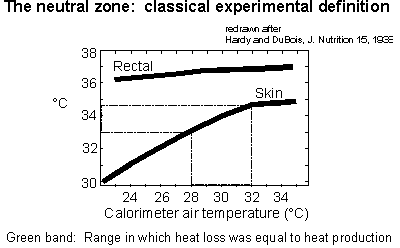
Experimental origins of the neutral zone concept

This physical range of 33 to 35 degrees was described in a classical paper by Hardy and DuBois (Hardy, J. D. and E. F. DuBois. Basal metabolism, radiation, convection and vaporization at temperatures of 22 to 35C. J. Nutr. 15: 477-497, 1938.). I believe that this is the first specific reference to a zone of thermal neutrality. The authors were the subjects of dozens of experiments in which thermal balance was analyzed by means of a calorimeter in which they were exposed for long periods to controlled ambient conditions. They observed that total heat production and total heat loss came into equilibrium only in the range of calorimeter temperatures indicated in green. On the high side, they sweated. On the low side, they shivered. In between, the associated range of skin temperature was approximately 33 to 35 degrees.
Other calorimetric studies performed in the same era confirmed these findings, specifically experiments of Burton and Bazett with a water bath calorimeter (Burton, A. C. and H. C. Bazett. A study of the average temperature of the tissues, of the exchanges of heat and vasomotor responses in man by means of a bath calorimeter. Am. J. Physiol.. 117: 36-54, 1936). Burton emphasized that these findings indicated that the body’s insulating layer is variable. He pointed out that the difference between core and surface temperature was only 2 degrees at one end of the neutral zone and it was at least double that at the other end.
To have the same heat transfer for a factor of two difference in temperature gradient, the effective insulation of the shell of peripheral tissues that surrounds the body core must differ by a factor of two.

In this illustration, the dark outline of the figure of a person represents the insulation thickness, thick on the left, thin on the right.
Burton interpreted this variable insulation as due to modulation of peripheral blood flow. I think it was his influence that led to the use of another name, "the vasomotor zone", synonymous with "neutral zone".
Ever since those days before the second world war, people have spoken in terms of "neutral zone" and "vasomotor zone" as these concepts found their way into the textbooks and the lore of temperature regulation.
Little experimental work has been done since. You can find some relatively recent papers that focus on what they call the "null zone" or "dead band" but they are really about thresholds for shivering and sweating at particular skin temperatures outside of the neutral range.
The major advance in the intervening years has been the recognition that the blood flow that is changing to vary heat transport and change the effective insulation of the shell is the blood flow in the skin. The only other vasculature that might participate is the vasculature of skeletal muscle and it seems to be indifferent to the influence of thermally driven reflexes that alter skin blood flow.
Click for next page , on Thermostatic temperature controllers or Return to index page